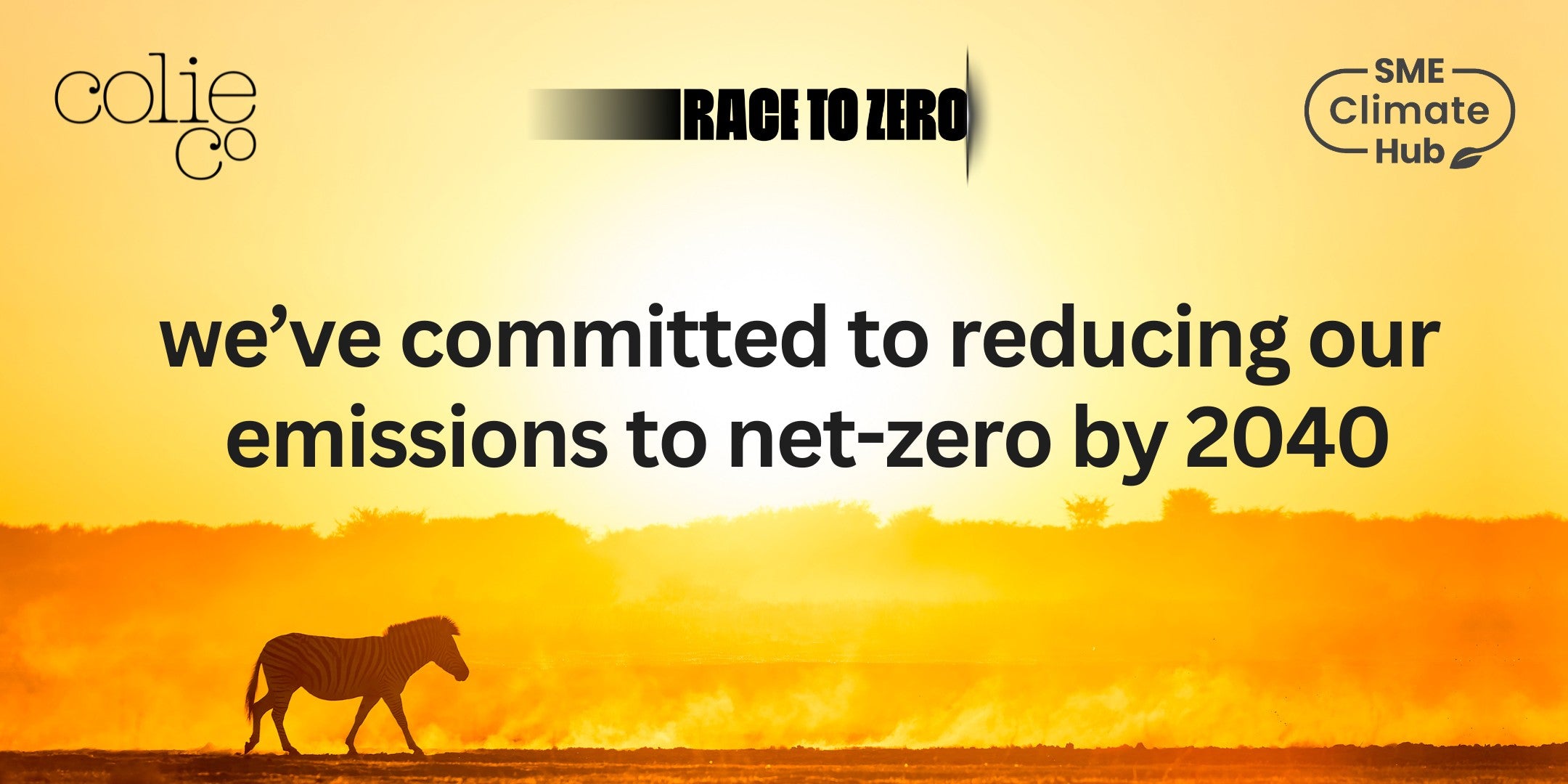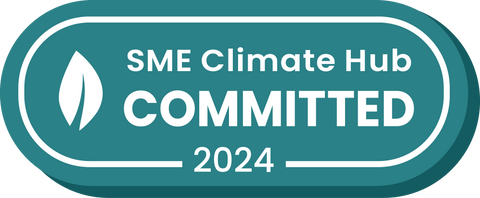Why We've Joined The UN's Race to Zero Campaign
We've committed to reducing our CO2e emissions to zero
I'm delighted to announce that ColieCo has joined the UN Climate Change Race to Zero campaign and made the SME Climate Commitment - a binding commitment to reduce our emissions from all sources to net-zero by 2040.
We've partnered with SME Climate Hub, a non-profit global initiative helping small to medium sized companies to take climate action, and will be working with them in ensuring we halve our emissions by 2030, achieve net-zero by 2040, and report on our progress against these targets on an annual basis.
In this blog post, we'll introduce the Race to Zero campaign and the SME Climate Commitment, explain exactly what the Climate Commitment means for ColieCo, detail the progress we've already made against the Commitment, and set out the next steps in our plan to meet the pledge.

Jump to:
- What is the Race to Zero campaign?
- What is the SME Climate Commitment?
- What does it mean to ColieCo to commit to carbon neutrality?
- What progress has ColieCo made already?
- Why has ColieCo set its net-zero target date as 2040?
- What's next for ColieCo's path to net-zero?
What is the Race to Zero campaign?
The UN's Race to Zero campaign is a global initiative aimed at rallying leadership and action towards achieving net-zero emissions by 2050. It brings together governments, businesses, cities, regions, and investors, all committed to halving emissions by 2030 and reaching a state of carbon neutrality by mid-century. The campaign encompasses various sectors, from energy and transport to agriculture and fashion, recognizing the interconnectedness of climate action across the economy.
The Race to Zero initiative holds paramount importance due to the pressing climate crisis. With the world experiencing unprecedented environmental challenges, urgent and coordinated efforts are imperative. The Race to Zero campaign provides a platform for organisations of all forms to collaborate, innovate, and accelerate the transition to a sustainable future.
What is the SME Climate Commitment?
The SME Climate Commitment provides SMEs (Small and Medium-sized Enterprises) across sectors with the opportunity to make an internationally recognised climate commitment aligned with the latest climate science and the UN Race to Zero campaign criteria.
SMEs that make the Climate Commitment agree to start taking action immediately toward three core targets:
- halving their greenhouse gas emissions before 2030
- achieving net zero emissions before 2050, and
- disclosing their progress every year.
These are the minimum levels of commitment and action. All enterprises are encouraged to take additional steps that reduce their emissions as quickly as possible.
What does it mean to ColieCo to commit to carbon neutrality?
As an eco-centric brand which has pledged to place sustainability at the heart of all we do, continually working to reduce our emissions - with the ultimate goal of achieving net-zero - has always been a critical part of our commitment to our core values.
This means that we have a head-start on the majority of businesses. But it also means, given the drivers behind our pledge, that we understand the importance of continuing to push ourselves as hard as we might to minimise our impact and the importance of meeting our goal.
Historically, our focus has been on identifying and taking opportunities where we saw potential improvements in our products and processes in terms of their net impact on the environment. We'd identify these potential changes, try to assess them holistically (considering factors from relative carbon intensity to water use to waste production and end-of-life), make immediate changes where we could, and prioritise where we couldn't.
What we hadn't done, and as we pledged to do in last year's report on our continuous improvement programme, was formally track and report on the progress we were making in terms of our carbon footprint.
With the help of SME Climate Hub and Normative, a leading carbon emissions calculating platform, we've now taken that step, and tracked our Scope 1, Scope 2 and, at a high level (more on that later), Scope 3 carbon emissions from 2020 through to year-end 2023. Going forward, each year we'll be undertaking the same process and reporting that data via the SME Climate Hub in line with our commitment to the Race to Zero campaign.
What progress has ColieCo made already?
The first core target of the SME Climate Commitment is to cut greenhouse gas emissions by at least 50% before 2030. Under the terms of the Climate Commitment, this means that a) Scope 1 and Scope 2 emissions must be cut in half by 2030 at the latest, and b) businesses should also aim to halve their most material Scope 3 emissions by 2030.
Scope 1 and Scope 2 emissions
Scope 1 emissions are direct (or in-house) greenhouse emissions from sources that are owned or controlled by an organisation, which can include the likes of emissions from manufacturing processes, burning fuels for heating and fleet vehicles.
ColieCo has never generated any Scope 1 emissions.
Scope 2 emissions are indirect greenhouse gas emissions related to the use of energy generated externally, i.e. electricity.
ColieCo has generated zero Scope 2 emissions since 2023 when we moved to a 100% renewable energy contract with our energy partner EDP Commercial to power the ColieCo Studio and our office.
This means that we have already met the first part of the first core target of the Climate Commitment in reducing our Scope 1 and Scope 2 emissions by at least 50% (and actually gone 50% better than that!).
Scope 3 emissions
Scope 3 emissions include all other indirect greenhouse gas emissions that occur across an organisation's end-to-end processes and are outside of the organisation’s direct control.
These might be easiest understood for ColieCo as (more or less) all the activities our suppliers and partners undertake along the supply chain before we receive our fabrics, components and packaging materials, and everything that happens after we dispatch our customers' orders.
Calculating Scope 3 emissions to any degree of accuracy is a challenge for any business, and for fashion brands it is an incredibly difficult undertaking, involving a detailed understanding of everything from the processes involved in extracting the various raw materials which will ultimately become different fabrics (having traced supply chains back to source), to measuring the end of life impacts of different types of garments.
The SME Climate Hub and Normative have provided us with the tools necessary to measure our Scope 3 emissions at a high level, but in order to better understand the impact of our end-to-end processes, we'll next be looking for an additional climate partner to help us drill down into the detail and calculate those emissions more accurately.
Why has ColieCo set its net-zero target date as 2040?
The SME Climate Commitment allows organisations to commit to reducing emissions to net-zero by 2030, 2040 or 2050. We have opted to set our target as 2040.
As will likely be the case for all direct-to-customer fashion brands who manufacture in-house and have a global customer base, a significant proportion of our Scope 3 emissions arise from the delivery of customers' orders.
We already do several things to try to ensure that we minimise the environmental impact of the delivery of orders, including shipping international orders by priority airmail services, rather than using courier services (which, universally, have much higher carbon footprints than airmail services), using the lightest packing materials available, and offering custom sizing across our collection to help minimise returns.
With the help of ClimeCo, we also offset 100% of the emissions associated with the delivery of customers' orders.

Ultimately, however, the aim is to reduce emissions to zero rather than offsetting, and in reducing Scope 3 emissions to zero, we are going to be reliant on the adoption of low carbon, and eventually net-zero, technologies by the global parcel delivery industry.
Significant progress is already being made across the industry, with the commercial airliners that airmail services piggyback on already utilising more sustainable aviation fuels, and postal services in all of our core markets - the US, the EU and the UK - working to replace expiring fleet vehicles with EVs. But this transition is going to take time.
As progress in made, we will continually be assessing and reassessing delivery services across the marketplace to ensure we identify and are utilising those which offer the very best net gains in terms of CO2e reduction.
What's next for ColieCo's path to net-zero?
Over the next six months, we will be:
- Engaging and working with a new climate partner to help us calculate our Scope 3 emissions more accurately
- Defining and setting out our short- and medium-term goals for Scope 3 emission reductions, and
- Developing our plan to achieve those goals.
To follow our progress, be sure to sign up to our newsletter via our homepage, follow us on social media, and look out for future blog posts, including our end of year report for 2024, which will provide full details of our emissions reduction plan and our progress against the same.
As always, please reach out with any questions or suggestions - we always appreciate your feedback and welcome anyone interested in joining the conversation.
Nicole x

